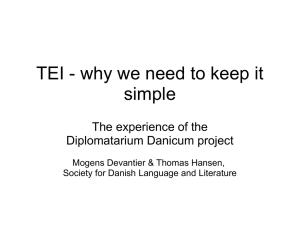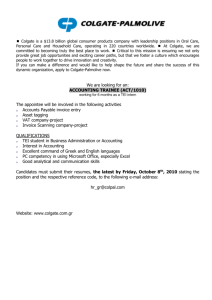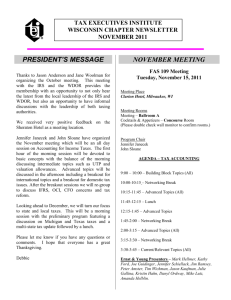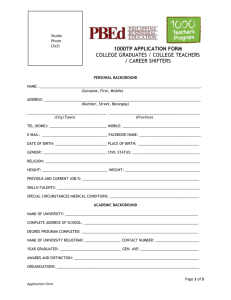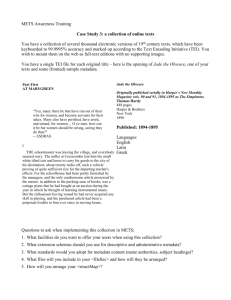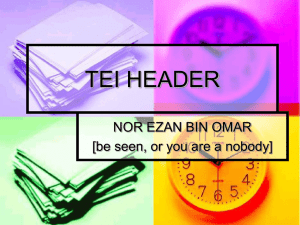ppt - Natural Language Server, Jožef Stefan Institute
advertisement
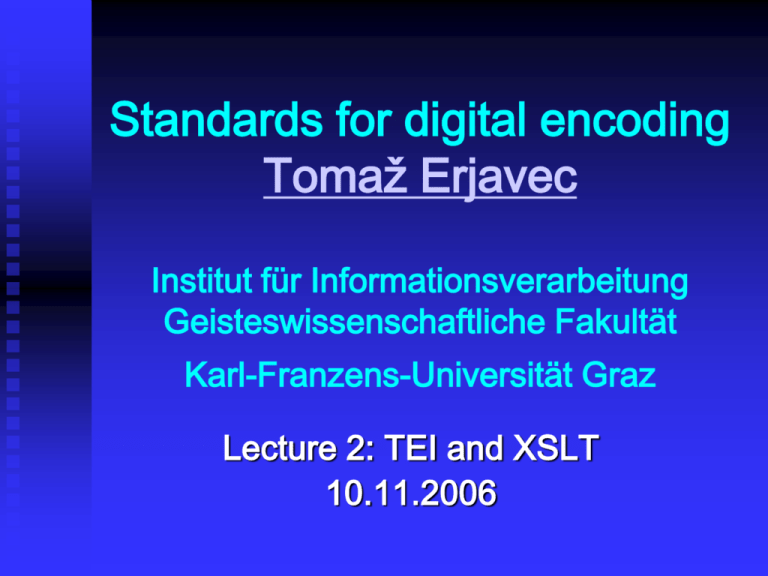
Standards for digital encoding Tomaž Erjavec Institut für Informationsverarbeitung Geisteswissenschaftliche Fakultät Karl-Franzens-Universität Graz Lecture 2: TEI and XSLT 10.11.2006 Lecturer Tomaž Erjavec Department of Knowledge Technologies Jožef Stefan Institute Ljubljana http://nl.ijs.si/et/ tomaz.erjavec@ijs.si corpora and other language resources, standards, annotation, text-critical editions Web page for this course: http://nl.ijs.si/et/teach/graz06/standards/ students: send emails! Overview Introduction 2. TEI background 3. TEI structure 4. Introduction to XSLT Lab session: writing a teiLite document, trasforming to HTML with XSLT 1. What’s in a text? What’s in a text (2)? What’s in a text (3)? The ontology of a text Where is the text? in the shape of letters and their layout? in the original from which this copy derives? in the ideas it brings forth? in their format, or their intentions? Texts are abstractions conjured up by readers. Markup encodes those abstractions. Encoding of texts Texts are more then sequences of encoded glyphs They have structure and content They also have multiple readings Encoding, or markup, is a way of making these things explicit Only that which is explicit can be reliably processed Styles of markup In the beginning there was procedural markup RED INK ON; print balance; RED INK OFF which being generalised became descriptive markup <balance type=’overdrawn’>some numbers</balance> also known as encoding or annotation descriptive markup allows for re-use of data Some more definitions Markup makes explicit the distinctions we want to make when processing a string of bytes Markup is a way of naming and characterizing the parts of a text in a formalized way It’s (usually) more useful to markup what things mean than what they look like What does markup capture? Compare <head>Upon Julia’s Clothes</head> <lg><l>Whenas in silks my <hi>Julia</hi> goes,</l> <l>Then, then (me thinks) how sweetly flowes</l> <l>That liquefaction of her clothes.</l> </lg> and <s n="1" role="head"> <w type="pp">Upon</w> <w type="np">Julia</w><w type="pos">’s </w> <w type="nn2">Clothes</w> </s> <s n="2" role="line"> <w type="adv">Whenas</w> <w type="pp">in</w> <w type="nn2">silks</w> ... </s> Likewise.. Compare <hi rend="dropcap">H</hi>&WYN;ÆT WE GARDE <lb/>na in gear-dagum þeod-cyninga <lb/>þrym gefrunon, hu ða æþelingas <lb/>ellen fremedon. oft scyld scefing sceaþe<add>na</add> <lb/>þreatum, moneg<expan>um</expan> mægþum meodo-setl<add>a</add> <lb/>of<damage desc="blot"/>teah egsode <sic>eorl</sic> syððan ærest wear<add>þ</add> <lb/>fea sceaft funden... and <lg> <l>Hwæt! we Gar-dena in gear-dagum</l> <l>þeod-cyninga þrym gefrunon,</l> <l>hu ða æþelingas ellen fremedon,</l> </lg> <lg> <l>Oft Scyld Scefing sceaþena þreatum,</l> <l>monegum mægþum meodo-setla ofteah;</l> <l>egsode Eorle, syððan ærest wearþ</l> What’s the point of markup? To make explicit (to a machine) what is implicit (to a person) To add value by supplying multiple annotations To facilitate re-use of the same material in different formats in different contexts for different users A useful mental exercise Imagine you are going to markup several thousand pages of complex material.... Which features are you going to markup? Why are you choosing to markup this feature? How reliably and consistently can you do this? Now, imagine your budget has been halved. Repeat the exercise! What can the TEI do for you? The TEI provides a framework for the definition of multiple schemas it defines and names several hundred useful textual distinctions it provides a set of modules that can be used to define schemas making those distinctions it provides a customization mechanism for modifying and combining those definitions with new ones using the same conceptual model Where did the TEI come from? Originally, a research project within the humanities Sponsored by three professional associations Funded 1990-1994 by US NEH, EU LE Programme et al. Major influences digital libraries and text collections language corpora scholarly datasets International consortium established June 1999 (see http://www.tei-c.org/) Goals of the TEI better interchange and integration of scholarly data support for all texts, in all languages, from all periods guidance for the perplexed: what to encode — hence, a user-driven codification of existing best practice assistance for the specialist: how to encode — hence, a loose framework into which unpredictable extensions can be fitted These apparently incompatible goals result in a flexible and modular environment TEI Guidelines A set of recommendations for text encoding, covering both generic text structures and some highly specific areas based on (but not limited by) existing practice A very large collection of element definitions with associated declarations for various schema languages a modular system for creating personalized schemas or DTDs from the foregoing for the full picture see http://www.tei-c.org/Guidelines2/ Legacy of the TEI a way of looking at what ‘text’really is a codification of current scholarly practice (crucially) a set of shared assumptions and priorities about the digital agenda: focus on content and function (rather than presentation) identify generic solutions (rather than application-specific ones) Users of TEI Over 100 projects listed on the TEI project page Main areas: digital libraries text-critical editions computer corpora dictionaries Versions of the Guidelines TEI P3 (1994) first public version: SGML + book (1200pp) and soon also on the Web. TEI P4 (2002): provides equal support for XML and SGML applications using the TEI scheme; error correction, while maintaining backward compatibility: documents conforming to TEI P3 will not become illegal when processed with TEI P4. TEI P5 (2006…): implements more fundamental changes to the schemas, in line with current practice and identified problems, e.g. uses namespaces no longer backward compatible (but a migration P4 to P5 XSLT exists) Relax NG becomes the main schema langauge still somewhat fluid (details in schemas, Web presentation) The general structure of TEI documents Burnard, Driscoll, Rahtz, TEI Training Course, Sofia 2005: Slides for TEI overview TEI Lite TEI Lite is a particular parametrisation of TEI that “provides 90% of the elements needed for 90% of users” the TEI Lite P4 DTD can be found at http://www.tei-c.org/Lite/DTD/teilite.dtd Lab session 1 again, recipes Bavarian-Style Pork Roast with Cabbage and Knödel and 2 others, e.g. from the Cabbage section take teiLite DTD and mark-up the documents according to TEI make use of documentation provided at TEI Lite page XSLT Erjavec: Course at ESSLII 2005 Annotation of Language Resources, Lecture II. XML-Related Recommendations: Formatting and Transforming XML ZVON tutorial W3schools …
